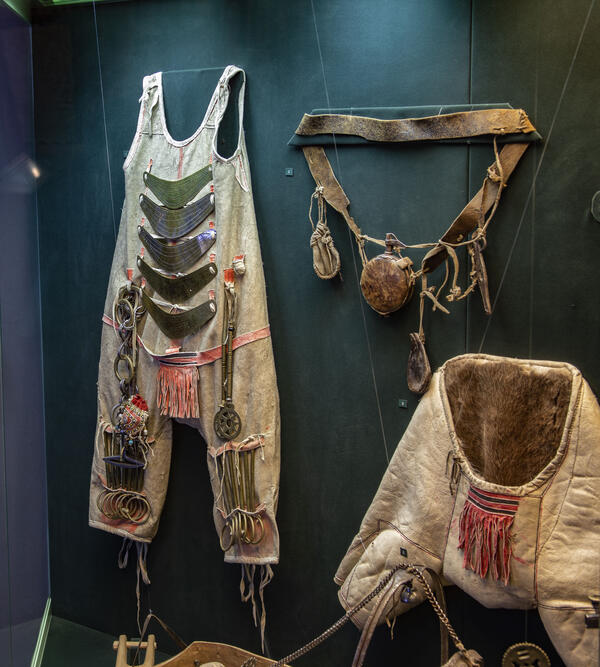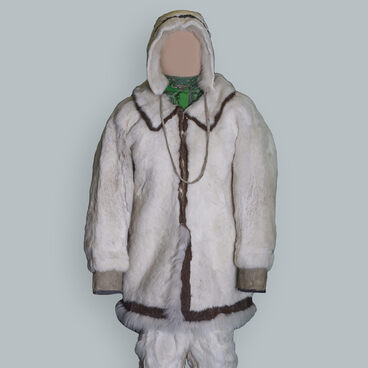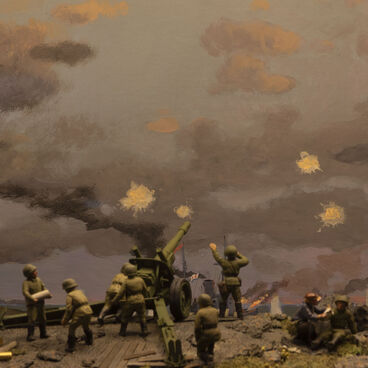The traditional underclothing of Nganasan women was overalls: winter ones were made of deer skin with a trimmed pile and fur on the inside, and summer ones — without sleeves (phonie) were made of suede of deer or elk skin.
The overalls, sewn with tendon threads, consist of two halves that are joined in the center of the back and front; there are no side seams. The cords passed in the hem of the trousers are tightened under the knee over the boot tops. Many items of clothing served as amulets. These include a black and red fringed belt made of suede and sewn on the front of the garment, and bodyamo.
Bodyamo are copper arc-shaped plates (five of them here) with stamped decorative patterns, suspended on suede straps on the chest. Women passed them as heirloom from generation to generation line; a woman’s status was known by their number. They were regarded as a woman’s “document” and were carefully guarded. The large copper ring to the right of the bodyamo was used to hang various items. Flint steel, a pipe cleaner, and a woman’s tobacco pouch were suspended from it on chains made of twisted wrought iron darts and copper rings.
The tobacco pouch with a button in the center is painted in black and red and decorated with embroidered using neck hair and beads. The beads are suspended at the bottom.
To the left of the bodyamo, there is a needle holder — sued straps with yellow copper tubes, decorated with circular grooves. The tubes served as covers: they were pulled up, needles were stuck into the suede and covered with copper “protectors” again. Eight-pointed pendants at the ends of the straps prevented the needles from slipping. A thimble was carried in a special pouch on the left side.
Copper tubes with rings — originally there were seven of those on each trouser leg (this exhibit lacks one) — are fixed on trouser legs with suede straps and connected at the top and bottom with red suede ribbons. This construction served simultaneously as a strong talisman, a support when carrying goods, as well as a rest for a cutting board or chopping board while sewing or cooking.
The overalls, sewn with tendon threads, consist of two halves that are joined in the center of the back and front; there are no side seams. The cords passed in the hem of the trousers are tightened under the knee over the boot tops. Many items of clothing served as amulets. These include a black and red fringed belt made of suede and sewn on the front of the garment, and bodyamo.
Bodyamo are copper arc-shaped plates (five of them here) with stamped decorative patterns, suspended on suede straps on the chest. Women passed them as heirloom from generation to generation line; a woman’s status was known by their number. They were regarded as a woman’s “document” and were carefully guarded. The large copper ring to the right of the bodyamo was used to hang various items. Flint steel, a pipe cleaner, and a woman’s tobacco pouch were suspended from it on chains made of twisted wrought iron darts and copper rings.
The tobacco pouch with a button in the center is painted in black and red and decorated with embroidered using neck hair and beads. The beads are suspended at the bottom.
To the left of the bodyamo, there is a needle holder — sued straps with yellow copper tubes, decorated with circular grooves. The tubes served as covers: they were pulled up, needles were stuck into the suede and covered with copper “protectors” again. Eight-pointed pendants at the ends of the straps prevented the needles from slipping. A thimble was carried in a special pouch on the left side.
Copper tubes with rings — originally there were seven of those on each trouser leg (this exhibit lacks one) — are fixed on trouser legs with suede straps and connected at the top and bottom with red suede ribbons. This construction served simultaneously as a strong talisman, a support when carrying goods, as well as a rest for a cutting board or chopping board while sewing or cooking.




